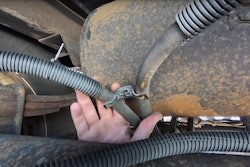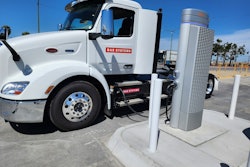The Department of Transportation on May 1 filed a 227-page Final Rule that allows oral fluid as an authorized testing method for the presence of unlawful drugs, giving fleets the option to subject drivers to urinalysis or a cheek swab for drug screenings.
Joining Jason and Matt this week on CCJ’s 10-44 is Brandon Wiseman, President of Trucksafe Consulting and partner with the Childress Law firm in Indianapolis, and they discuss what implications the new testing method may have on the number of drivers being snared in the Drug and Alcohol Clearinghouse, how fleets can safely (and legally) implement an oral fluid testing program, and much more.
This week's 10-44 is brought to you by Chevron Delo 600 ADF Ultra Low Ash diesel engine oil. It's time to kick some ash.
Jason Cannon (00:09):
The number of truck drivers stuck in the drug and alcohol clearing house is already six figures, and that's before the DOT unlocks a new screening and testing method next month. You're watching CCJs 10-44, a weekly episode that brings you the latest trucking industry news and updates from the editors of CCJ. Don't forget to subscribe and hit the bell for notifications so you'll never miss an installment of 10-44. Hey everybody, welcome back. I'm Jason Cannon and my co-host on the other side, as always is Matt Cole. From January 2022 to January 2023, the number of professional drivers and prohibited status with FMCSA's drug and alcohol clearing house with a violation jumped by more than 39,000 and through the first 60 days of this year, it's already up another 5,000.
Matt Cole (00:56):
ATA estimates there's a shortage of about 78,000 drivers industry-wide, but as of the most recent data available for FMCSA, about 126,000 drivers are sitting on the sidelines right now with a drug violation. More than 95,000 of them haven't even started the return to duty process.
Jason Cannon (01:13):
The number of drivers testing positive for drug use is pretty staggering, and that's mostly coming through urinalysis with very limited blood sampling. Brandon Wiseman, president of Truck Safe Consulting and a partner with the Childress' Law Firm in Indianapolis, he joins the 10-44 this week as we take a look at what we might can expect as it relates to positive tests once oral fluid testing becomes more viable later this year, and Brandon says there's a likelihood that we see the number of positive tests spike among a very specific group of drivers, cheaters.
Brandon Wiseman (01:44):
Obviously the problem in the industry with positive drug test and alcohol test is a major issue, but what we are doing with the new rule change in allowing for oral fluid testing in addition to urinalysis for DOT required drug screens, I don't know that it's going to cause those numbers to go up that much, perhaps maybe only in the sense that if nothing else, oral fluid testing makes it harder for drivers to cheat the system because they are directly observed when somebody's taken a mouth swab, they are sitting there right in front of you doing it versus urinalysis, many of which, most of which are not observed. And so there has been this problem over the years with some drivers trying to cheat the system. They try and substitute fake urine or somebody else's urine for their own and then maybe they get away with a test, a positive test that they should have had otherwise. So maybe we start to cut down on those instances of cheating. And so maybe we see the numbers go up a little bit because of that.
Matt Cole (02:44):
In theory, the oral fluid testing rule will take effect June 1st, but the Department of Health and Human Services first needs to certify two testing labs and it has not yet done that. Once that happens, which could take days, weeks, months, or more, Brandon thinks it's likely that oral fluid eventually becomes fleet's preferred means of testing.
Brandon Wiseman (03:03):
Even though this rule technically takes effect on June 1st, that does not necessarily mean you can start using oral fluid testing as of that date. We have to have at least two labs certified by the Department of Health and Human Services to process those tests because similar to urinalysis, we're going to have the split specimen. So the idea with that is, and this is how it works currently, you give your sample, that sample is split into two and the first sample is tested. If it comes back positive, then the driver can request that the split be tested by a different laboratory as kind of a protection for the process. And so we're going to have that with oral fluid testing as well. We're going to split the sample. That's why we need two labs so that we have one that's available to test the initial sample and then one available to test the split if a driver happens to request it.
(03:56):
Urinalysis, since it has been historically the only way, the only approved DOT drug testing method, obviously it's going to start off as be being the most prominent. That's what folks know, that's what they're used to. But I have no doubt that based on the ease of administering these types of oral fluid testing, that maybe we start to see a shift in that and maybe ultimately oral fluid tests overtake urinalysis when it comes to the most common type, just because again, they're mouth swabs. They're very easy to administer. From what I understand. They cost similar to maybe a little bit more right now than the cost to conduct a urinalysis test. But I expect as we start to see more and more of those tests that those costs will come down. And eventually, like I said, because of the ease of administration, I think we'll start to see those becoming very common.
Jason Cannon (04:46):
The process of taking oral fluids may be easier, but the testing process is a little bit more complex. Yeah, it's just a cheek swab, but the chemicals in the testing kit expire, which is something you don't have to deal with with urinalysis. So training and certification at the fleet level on administering these tests is going to be key.
Brandon Wiseman (05:03):
Something we haven't had to deal with urinalysis is an expiration date, so there is some concern there, which is why the DOT takes care in their regulations to make sure those that are collecting these types of samples are properly certified and trained to do the collection. So anybody who is going to be collecting oral fluid samples is going to have to receive training on that type of stuff, making sure that we're not doing these tests with an expired kit or anything like that. So it is a potential concern.
Matt Cole (05:33):
There are two big perceived benefits to oral fluid testing. Brandon tells us what those are after a word from 10-44 sponsor Chevron Lubricants.
Speaker 1 (05:42):
Protecting your diesel engine and its after treatment system has traditionally been a double-edged sword. The same engine oil that is so essential to protecting your engine's internal parts is also responsible for 90% of the ash that is clogging up your DPF and upping your fuel and maintenance costs. Outdated industry thinking still sees a trade-off between engine and emission system protection, and Chevron was tired of it, so they spent a decade of R&D developing a no compromise formulation.
(06:06):
Chevron Lubricants developed a new ultra low ash diesel engine oil that is specifically designed to combat DPF ash clogging. Delo 600 ADF with Omnimax technology cuts sulfate ash by whopping 60%, which reduces the rate of DPF clogging and extends DPF service life by two and a half times. And just think what you can do with all the MPGs you're going to add from cutting your number of regions. The Delo 600 ADF isn't just about after treatment. It provides complete protection, extending drain intervals by preventing oil breakdown. Before you had to choose between protecting your engine or your after treatment system, and now you don't. 600 ADF from Delo with Omnimax technology, it's time to kick some ash.
Brandon Wiseman (06:49):
Two big benefits are the... it's harder to cheat an oral fluid test than it is urinalysis, just like I said, because by their nature, they are always observed by the collector of the specimen. They are always going to be sitting there right in front of your face when they swab your cheek. So it significantly lessens the chance of any funny business in the drug testing process. So hopefully that means that we can have more comfort in the results that we receive in the testing program. That's the primary benefit of oral fluid testing.
(07:24):
But the other one is, like I said, the ease of an administration. What I expect will happen, you don't see this very often where motor carriers do their own urinalysis. Some of them, particularly the larger ones, have in-house clinics that will do it, but more often than not, we're talking about sending drivers out to a clinic, to a third party clinic to get the collection done O of the urine. But with oral fluid testing, because it's so easy to administer just via a mouth swab, I anticipate that a lot of motor carriers will go to the effort of getting some of their own employees certified to take these specimens so that they can get it done a lot quicker than the process is currently. So those are the two big benefits I think.
Jason Cannon (08:06):
So the DOT signed off on oral fluid testing, and once those two labs are certified, fleets can go grab those swab kits and implement it as part of their testing regimen right alongside your analysis. Right? Brandon says, it's not quite that easy unless you like getting dinged as part of an audit.
Brandon Wiseman (08:21):
Whatever you decide to do, whether you're going to use either or or a combination of both, make sure that you make that very clear in your drug and alcohol testing policy that you have to have as a regulated motor carrier and that you have to give to your drivers so it's clear to them when a particular test type is going to be used. And also, if you rely on the services of third party collection sites, make sure that you are on the same page with them in terms of what type of test you are expecting to administer in particular situations so that you don't screw something up. Don't screw up your policy. I've seen this so many times. We work with a lot of fleets of all types and sizes that have CDL drivers. The regulations require you to have a written drug and alcohol testing policy, and it very clearly spells out in the regulation what things have to be discussed in that policy.
(09:15):
And we see this so much where fleets will bring me a policy that they have not touched in the last five years, and it's missing things that are required by the regulation. That is low hanging fruit to an auditor if you ever get audited and I see it routinely written up as a violation in audits and then it leads to fines. So my advice to you is to now is a good time to revisit your drug and alcohol policy. Make sure it is up-to-date, make sure the last big change that we had in drug and alcohol testing was the clearinghouse. I see a lot of policies that don't talk about the clearinghouse. That's a violation, not to mention the clearinghouse requirements in your policy. So just make sure it's up-to-date, dusted off, and add some information about how you're going to do oral fluid testing once we get to that point.
Speaker 1 (10:03):
That's it for this week's 10-44. You can read more on ccjdigital.com. While you're there, sign up for our newsletter and stay up to date on the latest in trucking industry news and trends. If you have any questions or feedback, please let us know in the comments below. Don't forget to subscribe and hit the bell for notifications so you can catch us again next week.










